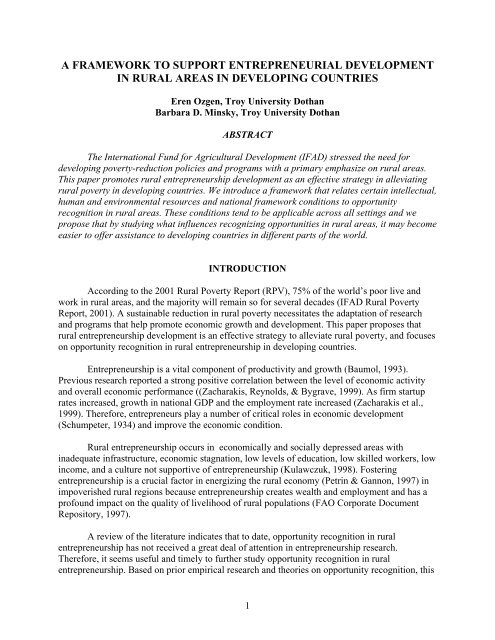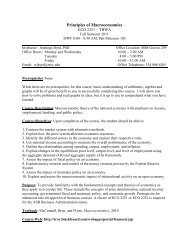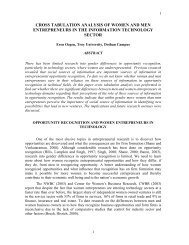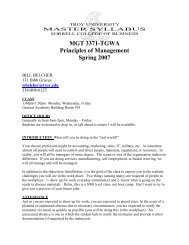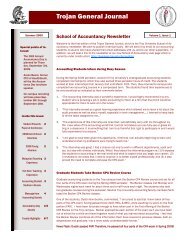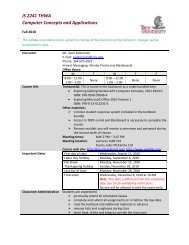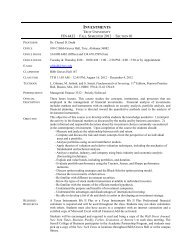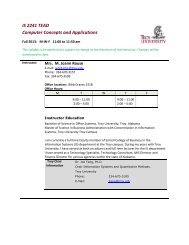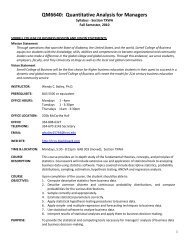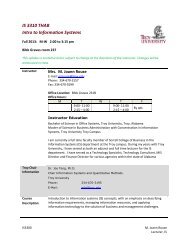a framework to support entrepreneurial development in rural
a framework to support entrepreneurial development in rural
a framework to support entrepreneurial development in rural
Create successful ePaper yourself
Turn your PDF publications into a flip-book with our unique Google optimized e-Paper software.
A FRAMEWORK TO SUPPORT ENTREPRENEURIAL DEVELOPMENTIN RURAL AREAS IN DEVELOPING COUNTRIESEren Ozgen, Troy University DothanBarbara D. M<strong>in</strong>sky, Troy University DothanABSTRACTThe International Fund for Agricultural Development (IFAD) stressed the need fordevelop<strong>in</strong>g poverty-reduction policies and programs with a primary emphasize on <strong>rural</strong> areas.This paper promotes <strong>rural</strong> entrepreneurship <strong>development</strong> as an effective strategy <strong>in</strong> alleviat<strong>in</strong>g<strong>rural</strong> poverty <strong>in</strong> develop<strong>in</strong>g countries. We <strong>in</strong>troduce a <strong>framework</strong> that relates certa<strong>in</strong> <strong>in</strong>tellectual,human and environmental resources and national <strong>framework</strong> conditions <strong>to</strong> opportunityrecognition <strong>in</strong> <strong>rural</strong> areas. These conditions tend <strong>to</strong> be applicable across all sett<strong>in</strong>gs and wepropose that by study<strong>in</strong>g what <strong>in</strong>fluences recogniz<strong>in</strong>g opportunities <strong>in</strong> <strong>rural</strong> areas, it may becomeeasier <strong>to</strong> offer assistance <strong>to</strong> develop<strong>in</strong>g countries <strong>in</strong> different parts of the world.INTRODUCTIONAccord<strong>in</strong>g <strong>to</strong> the 2001 Rural Poverty Report (RPV), 75% of the world’s poor live andwork <strong>in</strong> <strong>rural</strong> areas, and the majority will rema<strong>in</strong> so for several decades (IFAD Rural PovertyReport, 2001). A susta<strong>in</strong>able reduction <strong>in</strong> <strong>rural</strong> poverty necessitates the adaptation of researchand programs that help promote economic growth and <strong>development</strong>. This paper proposes that<strong>rural</strong> entrepreneurship <strong>development</strong> is an effective strategy <strong>to</strong> alleviate <strong>rural</strong> poverty, and focuseson opportunity recognition <strong>in</strong> <strong>rural</strong> entrepreneurship <strong>in</strong> develop<strong>in</strong>g countries.Entrepreneurship is a vital component of productivity and growth (Baumol, 1993).Previous research reported a strong positive correlation between the level of economic activityand overall economic performance ((Zacharakis, Reynolds, & Bygrave, 1999). As firm startuprates <strong>in</strong>creased, growth <strong>in</strong> national GDP and the employment rate <strong>in</strong>creased (Zacharakis et al.,1999). Therefore, entrepreneurs play a number of critical roles <strong>in</strong> economic <strong>development</strong>(Schumpeter, 1934) and improve the economic condition.Rural entrepreneurship occurs <strong>in</strong> economically and socially depressed areas with<strong>in</strong>adequate <strong>in</strong>frastructure, economic stagnation, low levels of education, low skilled workers, low<strong>in</strong>come, and a culture not <strong>support</strong>ive of entrepreneurship (Kulawczuk, 1998). Foster<strong>in</strong>gentrepreneurship is a crucial fac<strong>to</strong>r <strong>in</strong> energiz<strong>in</strong>g the <strong>rural</strong> economy (Petr<strong>in</strong> & Gannon, 1997) <strong>in</strong>impoverished <strong>rural</strong> regions because entrepreneurship creates wealth and employment and has aprofound impact on the quality of livelihood of <strong>rural</strong> populations (FAO Corporate DocumentReposi<strong>to</strong>ry, 1997).A review of the literature <strong>in</strong>dicates that <strong>to</strong> date, opportunity recognition <strong>in</strong> <strong>rural</strong>entrepreneurship has not received a great deal of attention <strong>in</strong> entrepreneurship research.Therefore, it seems useful and timely <strong>to</strong> further study opportunity recognition <strong>in</strong> <strong>rural</strong>entrepreneurship. Based on prior empirical research and theories on opportunity recognition, this1
paper <strong>in</strong>troduces a <strong>framework</strong> that relates certa<strong>in</strong> resources <strong>to</strong> opportunity recognition <strong>in</strong> <strong>rural</strong>areas: <strong>in</strong>tellectual and human resources such as education, knowledge, and tra<strong>in</strong><strong>in</strong>g, andenvironmental resources such as develop<strong>in</strong>g partnerships and access <strong>to</strong> cooperative <strong>rural</strong><strong>development</strong> centers. The <strong>framework</strong> also suggests that effects of these variables on opportunityrecognition <strong>in</strong> <strong>rural</strong> areas will be partially mediated by the national <strong>entrepreneurial</strong> <strong>framework</strong>conditions (i.e., the availability of f<strong>in</strong>ancial resources and <strong>in</strong>frastructure <strong>development</strong>).Overall, it is hoped that the ideas presented <strong>in</strong> this paper may provide helpful <strong>in</strong>sights <strong>in</strong><strong>to</strong>future entrepreneurship research and programs on the <strong>development</strong> of effective strategies <strong>in</strong> theimprovement of self-susta<strong>in</strong>ed <strong>rural</strong> communities <strong>in</strong> develop<strong>in</strong>g countries.Theoretical And Empirical BackgroundOpportunity recognition is one of the most fundamental issues <strong>in</strong> entrepreneurshipresearch (Kirzner, 1979; Shane & Ventakaraman, 2000; Ventakaraman, 1997). Prior studiessuggested that opportunity recognition is a jo<strong>in</strong>t function of an <strong>in</strong>dividual and the externalenvironment (S<strong>in</strong>gh, 2000). Entrepreneurs’ <strong>in</strong>teraction with the environment shapes the evolutionof ideas (De Kon<strong>in</strong>g, 1999; Shane & Ventakaraman; 2000; Vesper, 1990). In other words,personal, <strong>in</strong>terpersonal and societal fac<strong>to</strong>rs play the ma<strong>in</strong> role <strong>in</strong> <strong>entrepreneurial</strong> opportunityrecognition (Baron, 2004). Opportunity recognition is a process <strong>in</strong>fluenced by many contextualfac<strong>to</strong>rs <strong>in</strong> the external environment (Gaglio & Taub, 1992; Long & McMullan, 1984; S<strong>in</strong>gh,1998), most importantly the availability of resources (Timmons, 1994); the creative attributes ofan <strong>in</strong>dividual (Hills, Shrader, & Lumpk<strong>in</strong>, 1999), such as cognitive skills (Baron, 1998; DeKon<strong>in</strong>g, 1999); and prior knowledge of a particular field (Shane, 2000).Based on prior empirical research and theories that comb<strong>in</strong>e the role of an <strong>in</strong>dividual withthe external environment <strong>in</strong> the recognition of opportunities, we develop a <strong>framework</strong> foropportunity recognition <strong>in</strong> <strong>rural</strong> entrepreneurship <strong>in</strong> develop<strong>in</strong>g countries. The <strong>framework</strong>suggests that <strong>in</strong>tellectual and human capital (education and knowledge and tra<strong>in</strong><strong>in</strong>g programs)and environmental conditions (access <strong>to</strong> partnerships and cooperative <strong>rural</strong> <strong>development</strong> centers)play a key role <strong>in</strong> recogniz<strong>in</strong>g opportunities for viable new ventures <strong>in</strong> <strong>rural</strong> regions. We proposethat the extent <strong>to</strong> which the entrepreneur is exposed <strong>to</strong> these variables is positively related <strong>to</strong> thelikelihood of discover<strong>in</strong>g <strong>entrepreneurial</strong> opportunities <strong>in</strong> <strong>rural</strong> regions. The <strong>framework</strong> alsosuggests that effects of these variables on opportunity recognition <strong>in</strong> <strong>rural</strong> areas will be partiallymediated by the national <strong>entrepreneurial</strong> <strong>framework</strong> conditions (the availability of f<strong>in</strong>ancialresources for new firms <strong>in</strong> <strong>rural</strong> areas and <strong>in</strong>frastructure <strong>development</strong>).INTELLECTUAL AND HUMAN CAPITALIntellectual and human capital <strong>in</strong>volves the knowledge, education and tra<strong>in</strong><strong>in</strong>g of theentrepreneur.Education And KnowledgeThe low educational <strong>rural</strong> profile is one of the ma<strong>in</strong> contribu<strong>to</strong>rs <strong>to</strong> the grow<strong>in</strong>g rate ofeconomic and social differences and the disparity of <strong>in</strong>come between urban and <strong>rural</strong> regions.Education helps <strong>in</strong>crease the quality of human capital that is an essential part of an<strong>entrepreneurial</strong> society (Florida, 2002). Investment <strong>in</strong> skilled people and human capital2
<strong>development</strong> (Malecki, 1997) and tra<strong>in</strong><strong>in</strong>g the local community <strong>to</strong> participate <strong>in</strong> <strong>entrepreneurial</strong>activities are a crucial part of <strong>rural</strong> <strong>development</strong> (Petr<strong>in</strong> & Gannon, 1997). Educat<strong>in</strong>g <strong>rural</strong>residents who catalyze local resources <strong>to</strong> establish ventures <strong>in</strong> the <strong>rural</strong> areas improves thelivelihood of the <strong>rural</strong> poor.S<strong>in</strong>ce education is important <strong>in</strong> <strong>rural</strong> <strong>development</strong> and entrepreneurship, we suggest thateducat<strong>in</strong>g the <strong>rural</strong> community about basics of entrepreneurship and guid<strong>in</strong>g them throughprovid<strong>in</strong>g their own sources of revenue can help <strong>to</strong> <strong>in</strong>crease opportunity recognition <strong>in</strong> <strong>rural</strong>areas. This logic leads <strong>to</strong> the follow<strong>in</strong>g proposition. Proposition #1: The greater the extent <strong>to</strong>which <strong>rural</strong> entrepreneurs are educated <strong>in</strong> the <strong>entrepreneurial</strong> process, the more likely they willbe <strong>to</strong> discover opportunities for new ventures <strong>in</strong> <strong>rural</strong> areas.Tra<strong>in</strong><strong>in</strong>g ProgramsTra<strong>in</strong><strong>in</strong>g programs and previous learn<strong>in</strong>g create knowledge and shape <strong>in</strong>dividuals’ mental<strong>framework</strong>s, which then <strong>in</strong>fluence their perceptions of the external world (Baron, 2003).Tra<strong>in</strong><strong>in</strong>g programs that <strong>in</strong>volve <strong>rural</strong> entrepreneurship <strong>development</strong> may target eitheragricultural or nonagricultural sec<strong>to</strong>rs <strong>in</strong> the <strong>rural</strong> areas. Tra<strong>in</strong><strong>in</strong>g <strong>in</strong> agricultural sec<strong>to</strong>rs maytarget the application of suitable agricultural technologies and methods (Lohmoller, 1990).Hence, tra<strong>in</strong><strong>in</strong>g farmers on various production strategies and agricultural techniques promotesthe <strong>development</strong> of agricultural products and their process<strong>in</strong>g and may lead more entrepreneurs<strong>to</strong> recognize opportunities <strong>in</strong> <strong>rural</strong> regions (Lohmoller, 1990). Tra<strong>in</strong><strong>in</strong>g <strong>in</strong> non-agriculturalsec<strong>to</strong>rs will also teach <strong>rural</strong> residents various ways <strong>to</strong> diversify and develop other bus<strong>in</strong>ess areasand help them <strong>to</strong> <strong>in</strong>crease their options <strong>in</strong> entrepreneurship (Petr<strong>in</strong>, 1997). This leads directly <strong>to</strong>the next proposition. Proposition #2: The greater the extent <strong>to</strong> which <strong>rural</strong> entrepreneurs receivetra<strong>in</strong><strong>in</strong>g related <strong>to</strong> agricultural and/or non-agricultural sec<strong>to</strong>rs, the more likely they will discoveropportunities for new ventures <strong>in</strong> <strong>rural</strong> areas.ENVIRONMENTAL DIMENSIONSScann<strong>in</strong>g the external environment for <strong>in</strong>formation leads <strong>to</strong> <strong>entrepreneurial</strong> opportunities(Kaish & Gilad, 1991). Therefore, entrepreneurs identify opportunities by analyz<strong>in</strong>g theenvironment (Busenitz & Barney, 1997). In our <strong>framework</strong>, environmental dimensions <strong>in</strong>volvedevelop<strong>in</strong>g partnerships and access <strong>to</strong> cooperative <strong>rural</strong> <strong>development</strong> centers.Access To PartnershipsAccord<strong>in</strong>g <strong>to</strong> social network theory, entrepreneurs’ social ties <strong>in</strong>fluence their recognitionof <strong>entrepreneurial</strong> opportunities and <strong>entrepreneurial</strong> pursuits (Hills et al., 1997). The<strong>development</strong> of a <strong>rural</strong> <strong>entrepreneurial</strong> <strong>support</strong> system necessitates creat<strong>in</strong>g a <strong>support</strong>iveenvironment, or social network<strong>in</strong>g, <strong>to</strong> flourish <strong>in</strong> an <strong>entrepreneurial</strong> climate through build<strong>in</strong>gpartnerships (Dabson, 2005). Develop<strong>in</strong>g partnerships <strong>in</strong>cludes the coord<strong>in</strong>ated efforts of centralgovernment, local governments, municipalities, academies and non-governmental organizations<strong>to</strong> help spur the <strong>entrepreneurial</strong> activity of that region (Kulawczuk, 1998). Partnership with<strong>in</strong>stitutions, academies and various organizations encourage <strong>rural</strong> community <strong>development</strong> andstrengthen <strong>in</strong>stitutional <strong>support</strong> structures and well-built relations between the government andthe private sec<strong>to</strong>r <strong>in</strong> new enterprise <strong>development</strong> <strong>in</strong> <strong>rural</strong> prov<strong>in</strong>ces. Through jo<strong>in</strong>t efforts they3
<strong>in</strong>itiate various projects emphasiz<strong>in</strong>g <strong>development</strong> of bus<strong>in</strong>esses and <strong>rural</strong> communities. Thisleads <strong>to</strong> the next proposition. Proposition #4: The extent <strong>to</strong> which entrepreneurs have access <strong>to</strong>partnerships, the more likely they are <strong>to</strong> discover opportunities <strong>in</strong> <strong>rural</strong> regions.Cooperative Rural Development CentersRural <strong>entrepreneurial</strong> <strong>development</strong> requires improvement of <strong>support</strong> structures (Petr<strong>in</strong> &Gannon, 1997) <strong>to</strong> provide bus<strong>in</strong>ess counsel<strong>in</strong>g, assistance, a healthy <strong>entrepreneurial</strong>environment, and the establishment of an <strong>entrepreneurial</strong> culture with<strong>in</strong> the community.Cooperative <strong>rural</strong> <strong>development</strong> centers men<strong>to</strong>r and assist <strong>in</strong> the <strong>development</strong> of new ventureconcepts; advise on the assessment of new ventures; and provide technical assistance andcounsel<strong>in</strong>g for small bus<strong>in</strong>esses <strong>in</strong> <strong>rural</strong> areas. These centers form a men<strong>to</strong>r<strong>in</strong>g program withother successful entrepreneurs and provide forums for <strong>rural</strong> entrepreneurs <strong>to</strong> work with otherentrepreneurs <strong>to</strong> explore new opportunities. As entrepreneurs receive advice, knowledge andguidance from the cooperative <strong>rural</strong> <strong>development</strong> centers and engage <strong>in</strong> men<strong>to</strong>r<strong>in</strong>g programsthrough these centers, the likelihood of recogniz<strong>in</strong>g opportunities <strong>in</strong>crease, which leads <strong>to</strong> thenext proposition. Proposition #5: The extent <strong>to</strong> which entrepreneurs receive advice, knowledgeand guidance from the cooperative <strong>rural</strong> <strong>development</strong> centers is positively related <strong>to</strong> theirdiscoveries of opportunities <strong>in</strong> <strong>rural</strong> regions.THE MEDIATING EFFECT OF THE NATIONAL ENTREPRENEURIALFRAMEWORK CONDITIONSThe availability of f<strong>in</strong>ancial resources for new firms and the strength of <strong>in</strong>frastructureswere found <strong>to</strong> be highly correlated with the level of <strong>entrepreneurial</strong> activity across countries(Zacharakis et al., 1999). Includ<strong>in</strong>g these variables allows us <strong>to</strong> draw implications for otherdevelop<strong>in</strong>g countries as the concepts tend <strong>to</strong> be applicable across all sett<strong>in</strong>gs.Availability Of F<strong>in</strong>ancial ResourcesPromot<strong>in</strong>g <strong>rural</strong> entrepreneurship requires f<strong>in</strong>ancial resources such as funds for loans,<strong>in</strong>vestments and technical assistance for micro enterprises (Kulawczuk, 1998). In this paper, theavailability of f<strong>in</strong>ancial resources specifically refers <strong>to</strong> low <strong>in</strong>terest government loans, creditcounsel<strong>in</strong>g and technical assistance <strong>to</strong> <strong>rural</strong> entrepreneurs. F<strong>in</strong>ancial <strong>support</strong> may play a role <strong>in</strong>observ<strong>in</strong>g opportunities and creat<strong>in</strong>g motivation for <strong>in</strong>dividuals <strong>to</strong> exploit opportunities(Zacharakis et al., 1999). Therefore, it is rational <strong>to</strong> assume that <strong>in</strong>creas<strong>in</strong>g funds for <strong>rural</strong>regions enables <strong>rural</strong> residents <strong>to</strong> start their bus<strong>in</strong>esses. This leads the next proposition.Proposition #6: The greater the extent <strong>to</strong> which <strong>rural</strong> entrepreneurs have access <strong>to</strong> bus<strong>in</strong>essf<strong>in</strong>anc<strong>in</strong>g, the more likely they will discover opportunities for new ventures <strong>in</strong> <strong>rural</strong> areas.Infrastructure DevelopmentThe strength of <strong>in</strong>frastructure <strong>development</strong> plays a crucial role <strong>in</strong> <strong>rural</strong> entrepreneurship<strong>development</strong> (FAO documents, 1997). Infrastructure <strong>development</strong> is highly correlated with thelevel of <strong>entrepreneurial</strong> activity across different countries (Zacharakis et al., 1999). In this paper<strong>in</strong>frastructure <strong>development</strong> refers <strong>to</strong> develop<strong>in</strong>g and susta<strong>in</strong><strong>in</strong>g appropriate <strong>in</strong>frastructures <strong>in</strong><strong>rural</strong> areas. Previous research found that if there is a specific need <strong>in</strong> the community, spend<strong>in</strong>g on4
<strong>in</strong>frastructure improvements will be beneficial <strong>in</strong> encourag<strong>in</strong>g entrepreneurship (Bru<strong>in</strong>sma,Nijkamp, & Rietwald,1992).The strength of <strong>in</strong>frastructure <strong>in</strong> an area affects capacity build<strong>in</strong>g capabilities, reducessocio-economic barriers and <strong>in</strong>creases potential and possibilities for the region (Zacharakis et al.,1999). Therefore, spend<strong>in</strong>g on <strong>in</strong>frastructure <strong>development</strong> <strong>in</strong> <strong>rural</strong> regions leads <strong>to</strong> a change <strong>in</strong>the <strong>in</strong>dustry structure and creates a new demand and supply curve for new ideas and resources,which <strong>in</strong> turn impacts the availability of opportunities. This leads <strong>to</strong> the next proposition.Proposition #7: The extent <strong>to</strong> which entrepreneurs have access <strong>to</strong> <strong>rural</strong> <strong>in</strong>frastructure<strong>development</strong>, the more likely they are <strong>to</strong> discover opportunities <strong>in</strong> <strong>rural</strong> regions.The level of national <strong>framework</strong> conditions can facilitate the growth of an <strong>entrepreneurial</strong>sec<strong>to</strong>r <strong>in</strong> a country (Zacharakis et al., 1999). S<strong>in</strong>ce basic <strong>in</strong>frastructure <strong>development</strong> andavailability of f<strong>in</strong>anc<strong>in</strong>g (Kulawczuk, 1998) are necessary for any <strong>entrepreneurial</strong> venture, it isassumed that a country’s rate of the <strong>development</strong> of the national <strong>framework</strong> conditions may be acrucial l<strong>in</strong>k between a variety of other social, <strong>in</strong>tellectual and environmental dimensions and<strong>rural</strong> opportunity recognition <strong>in</strong> a country. As each develop<strong>in</strong>g country has a different level ofnational <strong>entrepreneurial</strong> <strong>framework</strong> conditions, it is suggested that the impact of <strong>in</strong>tellectual,human, and environmental resources on opportunity recognition is partially mediated by thenational <strong>entrepreneurial</strong> <strong>framework</strong> conditions. Hence, Proposition #8 and #9. Proposition #8:The effect of <strong>in</strong>tellectual, human, and environmental resources on opportunity recognition ispartially mediated by the availability of f<strong>in</strong>ancial resources <strong>in</strong> a particular country.Proposition # 9:The effect of <strong>in</strong>tellectual, human, and environmental resources on opportunityrecognition is partially mediated by <strong>in</strong>frastructure <strong>development</strong> of a particular country.INSIGHTS FOR FUTURE RESEARCH AND SUGGESTIONS FOR POLICY OPTIONSCONDUCIVE FOR RURAL ENTREPRENEURSHIP DEVELOPMENTInitiat<strong>in</strong>g <strong>rural</strong> entrepreneurship is a multidimensional strategy that <strong>in</strong>volves education,tra<strong>in</strong><strong>in</strong>g, bus<strong>in</strong>ess/<strong>support</strong> networks and build<strong>in</strong>g strong <strong>in</strong>frastructures <strong>to</strong> assist <strong>rural</strong>entrepreneurs <strong>in</strong> identify<strong>in</strong>g <strong>rural</strong> bus<strong>in</strong>ess opportunities and develop new bus<strong>in</strong>esses.Strengthen<strong>in</strong>g the <strong>rural</strong> <strong>entrepreneurial</strong> system will speed up the establishment of selfsusta<strong>in</strong>ed<strong>rural</strong> communities, <strong>in</strong>crease sources of <strong>in</strong>come, <strong>support</strong> <strong>development</strong> of <strong>in</strong>frastructure,build capacity, revitalize the <strong>rural</strong> community, and make a significant impact <strong>in</strong> alleviat<strong>in</strong>gpoverty. Therefore, what is needed is further entrepreneurship research <strong>in</strong> develop<strong>in</strong>g countriesthat help <strong>to</strong> create policies conducive for <strong>rural</strong> entrepreneurship <strong>development</strong>.The ideas presented <strong>in</strong> this paper are a step <strong>to</strong>wards future entrepreneurship research <strong>in</strong><strong>rural</strong> areas. We propose further empirical <strong>in</strong>vestigation of the <strong>framework</strong> presented <strong>in</strong> this paper.Overall, opportunity recognition <strong>in</strong> <strong>rural</strong> entrepreneurship is a complex issue and requiresentrepreneurship research and the <strong>development</strong> of policy <strong>in</strong>itiatives.5
REFERENCESIFAD. (2001). International Fund for Agricultural Development, Rural Poverty Report: Thechallenge of end<strong>in</strong>g <strong>rural</strong> poverty.http://www.ifad.org/poverty/chapter2.pdfBaron, R. (1998). Cognitive mechanisms <strong>in</strong> entrepreneurship: why and when entrepreneurs th<strong>in</strong>kdifferently than other people. Journal of Bus<strong>in</strong>ess Ventur<strong>in</strong>g, 13 (4), 275-294.Baron, R.A. (2004). Opportunity Recognition: Insights from a cognitive perspective. In J.Butler (Ed.)., Research <strong>in</strong> Entrepreneurship and Management (Vol. 4; pp. 47-73.)Information Age Publishers: Greenwich Ct.Baumol, W. (1993). Entrepreneurship, Management and the structure of Payoffs. The MITPress. Cambridge: Massachusetts.Bru<strong>in</strong>sma, F., Nijkamp, P., & Rietwald, P. (1992). Regional economic transformation & socialoverhead <strong>in</strong>vestments. Tijdschrift voor Economische en Sociale Geografie. 83: 3-12.Busenitz, L.W., and Barney, J.B. (1997). Differences between entrepreneurs and managers <strong>in</strong>large organizations: Biases and heuristics <strong>in</strong> strategic decision-mak<strong>in</strong>g. Journal of Bus<strong>in</strong>essVentur<strong>in</strong>g, 12, 9-30.Dabson, B. (2005).The Big Picture Context for Rural Entrepreneurship, Iowa CommunityEntrepreneurship Academy <strong>in</strong> Mann<strong>in</strong>g, Iowa.De Kon<strong>in</strong>g, A.J. (1999). Opportunity Formation From A Socio-Cognitive Perspective. Frontiersof Entrepreneurship Research, Wellesley, MA: Babson College, 258.Florida, R. (2002). The Rise of the Creative Class: And How It's Transform<strong>in</strong>g Work, Leisure,Community and Everyday Life. Perseus Books Group.Food and Agriculture Organization of the United Nations (FAO) Document Reposi<strong>to</strong>ry (FAO)Documents. 1997.http://www.fao.org/documents/show_cdr.asp?url_file=/DOCREP/W6882e/w6882e.htmGaglio, C.M., & Taub, P. (1992). Entrepreneurs and Opportunity Recognition. Frontiers ofEntrepreneurship Research, Wellesley, MA: Babson College, 136-147.Hills, G.E., Shrader, R.C., and Lumpk<strong>in</strong>, G.T. (1999). Opportunity recognition as a creativeprocess. Frontiers of Entrepreneurship Research, Wellesley, MA: Babson College, 216-27;Kaisch, S., and Gilad, B. (1991). Characteristics of opportunities search of entrepreneurs vs.executives: sources, <strong>in</strong>terest, and general alertness. Journal of Bus<strong>in</strong>ess Ventur<strong>in</strong>g, 6, 45-61.Kirzner, I. (1979). Perception, Opportunity and Profit. Chicago, IL: University of Chicago Press.6
Kulawczuk, P. (1998). The <strong>development</strong> of entrepreneurship <strong>in</strong> <strong>rural</strong> areas. Chapter 5: p.97.-109. In J.D. Kimball eds., The Transfer of Power: Decentralization <strong>in</strong> Central and EasternEurope. The Local Government and Service Form Initiative. Budapest: Hungary.Löhmöller, G. (1990). Concept for the <strong>development</strong> of <strong>entrepreneurial</strong> activities <strong>in</strong> the <strong>rural</strong> areafor farmers and managers of small- and medium-sized enterprises . Paper presented at the FifthSession of the FAO/ECA Work<strong>in</strong>g Party on Women and the Agricultural Family <strong>in</strong> RuralDevelopment, Prague, Czechoslovakia, 2-5 Oc<strong>to</strong>ber.Long, W., and McMullan, W. E. (1984). Mapp<strong>in</strong>g the New Venture Opportunity IdentificationProcess. Frontiers of Entrepreneurship Research, Wellesley, MA: Babson College, 567-590.Malecki, E, J. (1997). Technology and Economic Development: the Dynamics of Local,Regional, and National Competitiveness, Longman, Essex, EnglandPetr<strong>in</strong>, T. (1997). Entrepreneurial <strong>development</strong> process; a tra<strong>in</strong><strong>in</strong>g approach. In Food andAgriculture Organization of the United Nations (FAO) Document Reposi<strong>to</strong>ry. REU TechnicalSeries. 41.http://www.fao.org/documents/show_cdr.asp?url_file=/DOCREP/W6882e/w6882e.htmPetr<strong>in</strong>, T., & Gannon, A. (1997). Rural <strong>development</strong> through entrepreneurship. FAO, Rome(Italy). Regional Office for Europe.http://www.fao.org/documents/show_cdr.asp?url_file=/DOCREP/W6882e/W6882e00.htmSchumpeter, J.A. (1934). The Theory of Economic Development. Cambride: Harvard UniversityPress. (New York: Oxford University Press, 1961.) First published <strong>in</strong> German, 1912.Shane, S.A. (2000). Prior knowledge and the discovery of <strong>entrepreneurial</strong> opportunities.Organization Science, 11(4), 448-469.Shane, S., and Venkataraman, S. (2000). The promise of entrepreneurship as a field of research.Academy of Management Review, 25 (1), 217-226.S<strong>in</strong>gh, R. (1998). Entrepreneurial Opportunity Recognition through Social Networks.Unpublished doc<strong>to</strong>ral dissertation, University of Ill<strong>in</strong>ois at Chicago.Timmons, J.A. (1994). New Venture Creation: Entrepreneurship For The 21st Century (4thedition). Homewood, IL: Irw<strong>in</strong>Ventakaraman, S. (1997). The dist<strong>in</strong>ctive doma<strong>in</strong> of entrepreneurship research. In J. Katz (Ed.),Advances <strong>in</strong> Entrepreneurship: Firm Emergence and Growth, 3, 119-138.Vesper, K.H. (1990). New venture strategies. Englewood Cliffs. NJ: Prentice Hall.Zacharakis, A., Reynolds, P.D., & Bygrave, W.D. (1999). Global Entrepreneurship Moni<strong>to</strong>r:National Entrepreneurship Assessment: United States of America Executive Report.7


